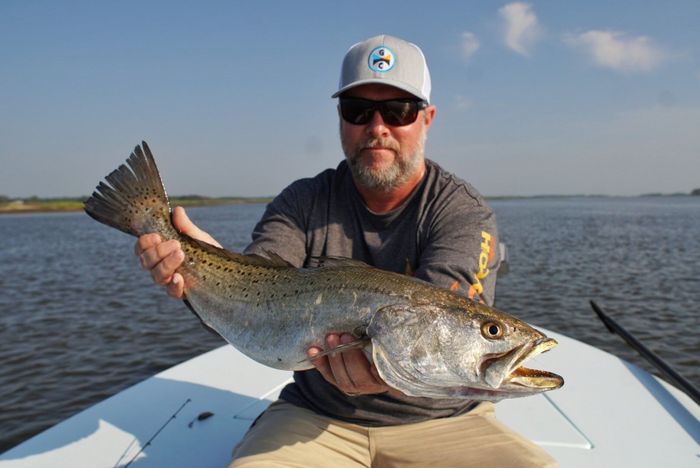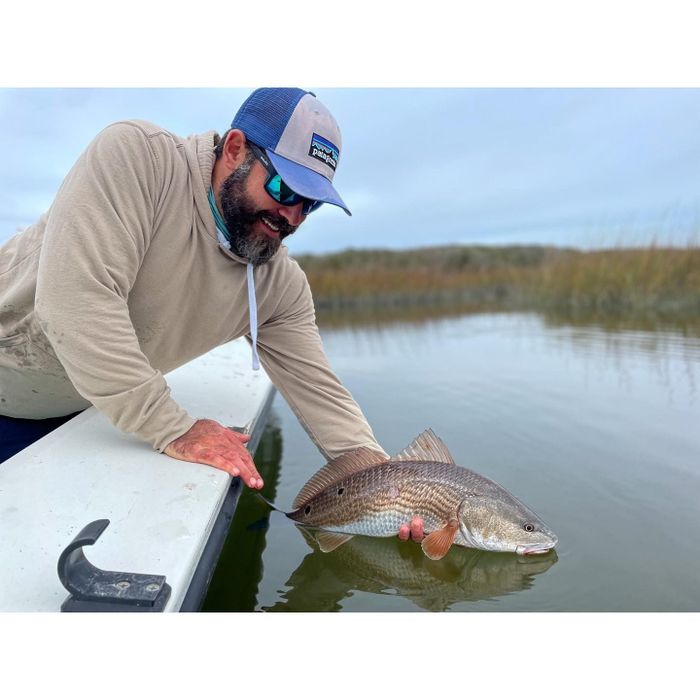Stalking Flood Tide Redfish: Expert Tips From Master Guide James Canelos
Redfish are one of the best trophy fish globally. James Canelos is a fishing expert that will help you catch them.

An Overview of Myself

For over 20 years, Captain James Canelos has been navigating and exploring the waters of St. Augustine in Florida. He specializes in fly fishing and inshore light spin fishing. This United States Coast Guard licensed captain showcases his years of experience and great depth of knowledge of local fisheries and fishing techniques by helping people of all kinds to become better anglers — all through his fishing guide service, All Water Expeditions.
When not out fishing in the bountiful habitats of St. Augustine, you can often find Captain James fishing in the Florida Keys, the Bahamas, and even in some of the excellent fisheries off the coast of Louisiana. He believes good guides never stop learning and refining their skills.
Book a guided fishing trip with Captain James Canelos today! His clients are consistently in ‘AWE’ (as his business acronym suggests) of his laidback, patient, and encouraging style of teaching.

Flood Tide Redfish Fishing in Northeast Florida
Northeast Florida, which includes St. Augustine, is a paradise for shallow water anglers and saltwater fishing enthusiasts because of its diverse habitats situated along the Intracoastal Waterway. One of the main draws is the excellent redfish fishing that the region offers. This area in Florida is an amazing place for anglers to target fish like redfish and sea trout year-round because of its creeks, marshes, oyster-lined flats, shell bank drop-offs, and spartina grass.
I’ve cracked the code when it comes to landing redfish in Northeast Florida’s flood tides. Here’s what you need to know when trying to look for these sought-after gamefish in flood tides:
Trailing Tailing Redfish in Flood Tides

Northeast Florida is home to vast saltwater marshes that extend up to North Carolina. Oyster beds, muddy flats, and spartina grass make for a naturally abundant and breathtakingly scenic environment. You can experience the vibe of ‘Old Florida’ when you navigate through the maze-like creek systems.
Within these marshes live various species of crabs, shrimp, and baitfish. The abundance of these food sources attracts predators such as various bird species and fish. But we all know the king of the marsh is the redfish. The redfish’s anatomy is designed for cruising the shallows of these areas as they furiously feed on crustaceans. They have large crushers in the back of their jaws that allow them to break apart shells of large crabs and other baits that may have other defense mechanisms.
Floridian flood tides and marshes are favorites among shallow redfish anglers. Because in these areas, fish are abundant, feed in the shallows, and make their presence known to sight-fishers. Most may not know that you can be presented with a unique opportunity to sight fish tailing reds within these marshes. Anglers who have experienced the hand-trembling adrenaline rush of casting a tailing fish will agree that it’s one of the ultimate fishing experiences.
At various times of the year, king tides are created from lunar phases coupled with high tides. When this happens, the water will flood the spartina grass, making areas that rarely see water flooded. This leaves small inhabitants, like forage shellfish and baitfish, vulnerable. Redfish and other species like trout can take advantage of this and will move into the flooded grass and root around for crabs. As redfish snoop about, they will ‘stand’ on their heads to eat fleeing bait. This causes an awe-inspiring display of fish tails waving above the surface. They’re so laser-focused on feeding that they lose their instincts to remain undetected. You can already imagine that this makes for a memorable fishing experience.

What You Need to Know
There are some things to consider before you rush out and start looking for tailing reds and other fish like trout in flood tides. Because this phenomenon does not occur too often, it’s important to be prepared and know how conditions need to align in order to make your angling experience rewarding.
Reading the Tides

Flood tides will occur in most months around the new and full moons. The bulk of these tides will be in the fall months, like September and October, and will naturally be at their highest point. Fall tends to be the most productive fishing season because fish are eating heavily to prepare for winter. So whether you're using live bait, flies, or whichever other bait or lure you choose, they’re more likely to get bitten during that season.
I think that having a reliable tide chart with moon phases will help you plan for flood tide opportunities. The National Oceanic and Atmospheric Administration releases bar pilot information that will give accurate depictions of water levels based on varying conditions and factors. Most flood tides will occur either in the evening or early morning. During the fall, a few will occur during the middle of the day, though this is quite uncommon. Evening tides tend to hold more fish, especially when there’s a full moon. The best time to fish a morning flood tide is when it’s associated with a new moon.
Considering Water Temperature
Though flood tides do occur in most months, fish will not always move into the grass. Crabs would be buried deep underground in colder months, leaving nothing for fish to eat. In my experience, December through March is not very productive for flood tide fishing. A good rule of thumb is to fish these tides when the water temperature is above 73 degrees.
How to Look for Flood Spots
Optimal areas are those that receive about a foot of water during these exceptional high tides. Look for areas that have a gray tint to them; it means water has been there before. The best of these areas will be flats that have feeder creeks leading up to them. This allows fish to have access to deeper water quickly, making them more comfortable. When you find areas that flood, study their characteristics. It will aid you in finding new spots.
Skiffs vs Wading
Even though the redfish are feeding heavily during this time, you’re still required to be stealthy. The best way to approach tailing redfish is by poling a shallow boat or wading to them on foot. When fishing from a skiff, the added height of the poling and casting platform will give you a better vantage point for spotting fishtailing from far away. Using a boat will always be the better choice. A skiff will also produce fewer vibrations and wakes as opposed to you tromping through the marsh. If you’re wading, remember to wear a good pair of shoes or wading boots to avoid stepping on rogue oyster shells in the grass. Wearing pants is also strongly recommended as the grass can make you itchy. Be sure to avoid deep feeder creeks when wading. Always walk in areas where the grass is visible above the water.
Fly Fishing in Flood Tides
Fly fishing is arguably the most productive way to fish in flood tides. Those who are new to the method can find one of the best opportunities to hone their skills fishing in flood tides. Why? Because fish are visible, slow-moving, and uneasily spooked. The required typical cast is only about 20-30 feet. The further you can cast, the less likely you’re visible to fish, but flood tide fishing is quite forgiving to the novice caster. If you’re not into fly fishing, using light spin gear will get the job done.

Flies
When choosing flies, it’s best to match the hatch. A crab pattern in black or brown will be your best bet. These are designed to imitate small fiddler crabs that most fish, like reds and trout, are feeding on. Flies should be the size of a quarter and tied on a size 1 hook. A stiff weed guard is also necessary because you will be casting directly into grass.
In my experience, orange flies trigger a bite. I like to incorporate some aspects of orange into my fly. I usually add orange chanelle near the eyes of the fly.
Sometimes fish will be slurping crabs hanging off the grass. When this happens, throw a gurgler pattern or floating crab, as fish are looking upward. I always have a second rod rigged with a surface fly in case I run into surface-feeding fish.
Lures
The main consideration when throwing lures is the size. The typical bait they’re feeding on is small, so throwing large lures won’t be natural. Soft plastics that imitate shrimp or crabs will work best. Look for these in black, dark brown, or new penny color.
Your lure should also be weighted properly to allow you castability, but not too heavy that it makes a large splash when presented. Typically a 1/8 oz jig head or weedless hook will be plenty of weight. If you’re using a jig head, make sure it’s weedless. Your bait should be able to slide through the grass without being snagged because fish will not eat a lure with grass on it.
Setting Up and Casting
There is no need to rush anything when you’re tailing fish in a flood. They’ll stick around because they’re busy feeding. But you should maintain enough distance that still allows you to make an accurate cast.
Before casting, observe what the fish is doing. Try to see if the fish is on a certain path. Oftentimes, a redfish or trout will tail to eat a crab and then move along for the next one. Try to predict the path they’re moving along. This will allow you to lay the cast out far enough to avoid spooking the fish.
When a fish is tailing hard, its attention is on what it’s trying to eat. This is not the best time to cast because their attention is elsewhere. Additionally, it’s tough to know where the head is actually looking when you just see the tail. This can lead to hitting the fish with a lure and scaring it off. The best time to cast is after the fish tails and starts its search for the next meal. At this point, they're looking for movement or feeling for fleeing bait. This will yield a better hook-up ratio. Always think about where its head is looking as opposed to focusing on its tail.
When casting, your bait should cross the fish at a 90-degree angle using small strips or retrieves. Position yourself before casting to get the proper angle. The absolute worst angle is bringing the lure to the fish because it will usually spook them. Remember, bait coming at a predator is not a natural occurrence, and they will know something isn’t right.
Fish will bite most of the time if your bait is presented properly. Fish taking to your fly or lure will be aggressive and an incredible experience! Once you’ve hooked your target, try to keep your rod tip high to avoid dragging against the grass.
Flood tide fishing is unique to certain areas of the country. Don’t miss out on the excitement fly fishing in flood tides brings because it will surely get you hooked! Book with me and All Water Expeditions to experience what every fly fisherman and sight fisherman should experience here in Florida! More information can be found on our website and Facebook page.




